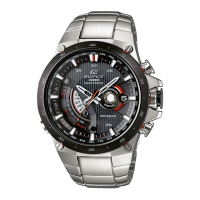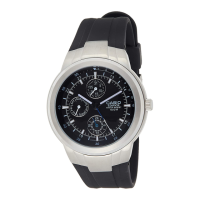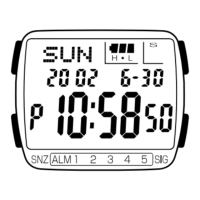Operation Guide 5117
1
MO0912-EA
Getting Acquainted
Congratulations upon your selection of this CASIO watch. To get the most out of your
purchase, be sure to read this manual carefully.
Keep the watch exposed to bright light
The electricity generated by the solar cell of the watch is
stored by a built-in battery. Leaving or using the watch
where it is not exposed to light causes the battery to run
down. Make sure the watch is exposed to light as much as
possible.
• When you are not wearing the watch on your wrist,
position the face so it is pointed at a source of bright
light.
• You should try to keep the watch outside of your sleeve
as much as possible. Charging is reduced significantly if
the face is only partially covered.
l
l
l
l
l
l
l
l
l
l
l
Bright Light
Solar cell
• The watch continues to operate, even when it is not exposed to light. Leaving the
watch in the dark can cause the battery to run down, which will result in some watch
functions to be disabled. If the battery goes dead, you will have to re-configure watch
settings after recharging. To ensure normal watch operation, be sure to keep it
exposed to light as much as possible.
All
functions
enabled
LEVEL 1
LEVEL 2
LEVEL 3
LEVEL 4
Charge
Rechargeable battery
Bright Light
Electrical
energy
Solar cell
(Converts light to
electrical power.)
LEVEL 1
LEVEL 2
LEVEL 3
LEVEL 4
Some or all
functions
disabled
Dis-
charge
Battery charges in the light. Battery discharges in the dark.
• The actual level at which some functions are disabled depends on the watch model.
• Frequent display illumination can run down the battery quickly and require charging.
The following guidelines give an idea of the charging time required to recover from a
single illumination operation.
Approximately 5 minutes exposure to bright sunlight coming in through a window
Approximately about 8 hours exposure to indoor fluorescent lighting
• Be sure to read “Power Supply” for important information you need to know
when exposing the watch to bright light.
If the display of the watch is blank...
If the display of the watch is blank, it means that the watch’s Power Saving function
has turned off the display to conserve power.
• See “Power Saving Function” for more information.
Note that CASIO COMPUTER CO., LTD. assumes no responsibility for any
damage or loss suffered by you or any third party arising through the use of this
product or its malfunction.
About This Manual
• Depending on the model of your watch, display text
appears either as dark figures on a light background or
light figures on a dark background. All sample displays
in this manual are shown using dark figures on a light
background.
• Button operations are indicated using the letters shown
in the illustration.
• Each section of this manual provides you with the
information you need to perform operations in each
mode. Further details and technical information can be
found in the “Reference” section.
General Guide
• Press C to change from mode to mode.
• In any mode (except when a setting screen is on the display), press B to illuminate
the display for about one second.
Timekeeping Mode
Press C.
Alarm Mode Countdown Timer Mode
▲
World Time Mode Stopwatch Mode
▲
▲
▲
▲
Radio-controlled Atomic Timekeeping
This watch receives a time calibration signal and updates its time setting accordingly.
• This watch is designed to pick up the time calibration signals transmitted in Germany
(Mainflingen), England (Anthorn), the United States (Fort Collins), China (Shangqiu),
and Japan (Fukushima, Fukuoka/Saga).
• See the information under “Signal Reception Troubleshooting” if you experience
problems with time calibration signal reception.
Current Time Setting
This watch adjusts its time setting automatically in accordance with a time calibration
signal. You also can perform a manual procedure to set the time and date, when
necessary.
• The first thing you should do after purchasing this watch is to specify your
Home City (the city where you normally will use the watch). For more
information, see “To specify your Home City”.
• When using the watch outside the areas covered by the time signal transmitters, you
will have to adjust the current time setting manually as required. See
“To set the time
and date manually” for more information about manual time settings.
• The U.S. time calibration signal can be picked up by the watch while in North
America. The term “North America” in this manual refers to the area that consists of
Canada, the continental United States, and Mexico.
• As of January 2009, China does not use Daylight Saving Time (DST). If China does
go to the Daylight Saving Time system in the future, some functions of this watch
may no longer operate correctly.
• Using this watch in a country covered by a time calibration that is different from the
countries it supports may result in incorrect time indication due to local application of
summer time, etc.
To specify your Home City
1. In the Timekeeping Mode, hold down A for about five
seconds until the left dial hand points to T1 and the city
code flashes on the upper display. This is the setting
screen.
2. Press D (east) and B (west) to select the city code
you want to use as your Home City.
LIS, LON : Lisbon, London
MAD, PAR , ROM, BER, STO : Madrid, Paris, Rome,
Berlin, Stockholm
ATH : Athens
MOW : Moscow
HKG, BJS, TPE : Hong Kong, Beijing, Taipei
SEL, TYO : Seoul, Tokyo
HNL : Honolulu
ANC : Anchorage
YVR, LAX : Vancouver, Los Angeles
YEA, DEN : Edmonton, Denver
MEX, CHI : Mexico City, Chicago
l
l
l
l
l
l
l
l
l
l
l
l
l
l
City code
Hour : Minutes
PM indicator Seconds
Left dial
hand
MIA, YTO, NYC : Miami, Toronto, New York
YHZ : Halifax
YYT : St.Johns
3. Press A twice to exit the setting screen.
• Normally, your watch should show the correct time as soon as you select your Home
City code. If it does not, it should adjust automatically after the next auto receive
operation (in the middle of the night). You also can perform manual receive or you
can set the time manually.
• The watch will receive the time calibration signal automatically from the applicable
transmitter (in the middle of the night) and update its settings accordingly. For
information about the relationship between city codes and transmitters, see
“Important!” under “Time Calibration Signal Reception” and “Transmitters”.
• See the maps under “Approximate Reception Ranges” for information about the
reception ranges of the watch.
Time Calibration Signal Reception
There are two different methods you can use to receive the time calibration signal:
auto receive and manual receive.
• Auto Receive
With auto receive, the watch receives the time calibration signal automatically up to six
times a day (five times for the China signal). When any auto receive is successful, the
remaining auto receive operations are not performed. For more information, see
“About Auto Receive”.
• Manual Receive
Manual receive lets you start a time calibration receive operation with the press of a
button. For more information, see “To perform manual receive”.
Important!
• When getting ready to receive the time calibration signal, position the watch as
shown in the nearby illustration, with its 12 o’clock side facing towards a window.
This watch is designed to receive a time calibration signal late at night. Because of
this, you should place the watch near a window as shown in the illustration when you
take it off at night. Make sure there are no metal objects nearby.
12 o’clock
or
• Make sure the watch is facing the right way.












